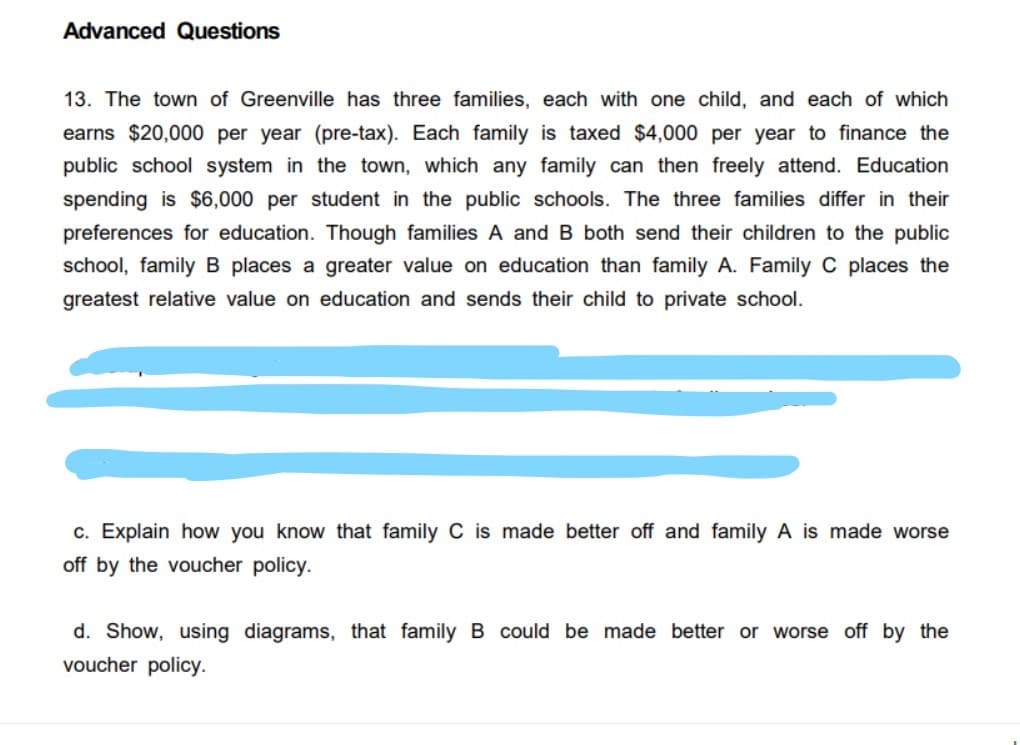Advanced Questions 13. The town of Greenville has three families, each with one child, and each of which earns $20,000 per year (pre-tax). Each family is taxed $4,000 per year to finance the public school system in the town, which any family can then freely attend. Education spending is $6,000 per student in the public schools. The three families differ in their preferences for education. Though families A and B both send their children to the public school, family B places a greater value on education than family A. Family C places the greatest relative value on education and sends their child to private school. c. Explain how you know that family C is made better off and family A is made worse off by the voucher policy. d. Show, using diagrams, that family B could be made better or worse off by the voucher policy.
Advanced Questions 13. The town of Greenville has three families, each with one child, and each of which earns $20,000 per year (pre-tax). Each family is taxed $4,000 per year to finance the public school system in the town, which any family can then freely attend. Education spending is $6,000 per student in the public schools. The three families differ in their preferences for education. Though families A and B both send their children to the public school, family B places a greater value on education than family A. Family C places the greatest relative value on education and sends their child to private school. c. Explain how you know that family C is made better off and family A is made worse off by the voucher policy. d. Show, using diagrams, that family B could be made better or worse off by the voucher policy.
Chapter12: The Partial Equilibrium Competitive Model
Section: Chapter Questions
Problem 12.11P
Related questions
Question

Transcribed Image Text:Advanced Questions
13. The town of Greenville has three families, each with one child, and each
which
earns $20,000 per year (pre-tax). Each family is taxed $4,000 per year to finance the
public school system in the town, which any family can then freely attend. Education
spending is $6,000 per student in the public schools. The three families differ in their
preferences for education. Though families A and B both send their children to the public
school, family B places a greater value on education than family A. Family C places the
greatest relative value on education and sends their child to private school.
c. Explain how you know that family C is made better off and family A is made worse
off by the voucher policy.
d. Show, using diagrams, that family B could be made better or worse off by the
voucher policy.
Expert Solution
This question has been solved!
Explore an expertly crafted, step-by-step solution for a thorough understanding of key concepts.
This is a popular solution!
Trending now
This is a popular solution!
Step by step
Solved in 2 steps with 2 images

Knowledge Booster
Learn more about
Need a deep-dive on the concept behind this application? Look no further. Learn more about this topic, economics and related others by exploring similar questions and additional content below.Recommended textbooks for you


Exploring Economics
Economics
ISBN:
9781544336329
Author:
Robert L. Sexton
Publisher:
SAGE Publications, Inc

Principles of Economics 2e
Economics
ISBN:
9781947172364
Author:
Steven A. Greenlaw; David Shapiro
Publisher:
OpenStax


Exploring Economics
Economics
ISBN:
9781544336329
Author:
Robert L. Sexton
Publisher:
SAGE Publications, Inc

Principles of Economics 2e
Economics
ISBN:
9781947172364
Author:
Steven A. Greenlaw; David Shapiro
Publisher:
OpenStax